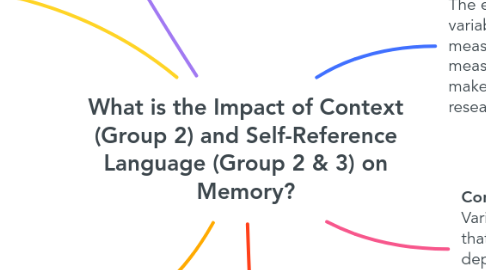What is the Impact of Context (Group 2) and Self-Reference Language (Group 2 & 3) on Memory?
Maiko FUJIHARAにより

1. **Dependent Variable** The effect of the independent variable was collected was measured through objective data - measurements that the participant makes that can be verified by the researcher
1.1. Accurate way of collecting information about the participant’s recall, as it can be verified by the researcher (checking of words), meaning it is free from bias.
1.2. Quantitative data (word count) is easy to compare between groups
2. **Research Design Type** - Advantages and disadvantages in the experimental design and the independent variable. In an experimental design, the independent variable is manipulated, and the influence is tested through measurements (dependent variable). In this experiment, the independent variable was the three groups, each with a different method of presenting the list of words to be memorised. Group 1 (control) was provided with the words only, Group 2 received the words and context, and Group 3 received words, context and self-reference imagery cues.
2.1. **Advantage:** the experiment is easy to replicate, as compared to an observational design, the researcher manipulates the independent variable. The same list of words could be used across all three groups to be recorded and marked, clearly showing the effect of word recall. Testing both context and self-reference allows the researcher to compare the effect of both background information and emotions associated to the words
2.2. **Disadvantage:** a potential problem in this design was the word list, which consisted of ten words associated with music. For participants familiar with music, this could have been an advantage, as human memory strongly tends to relate new knowledge with pre-existing information more efficiently (Bartlett, 1932).
2.3. **Disadvantage**: The time to read out context and imagery cues takes longer than just the words, meaning that Group 3’s test took the longest time. As people may be exposed to more information with more time going by, this may reduce their memory. On the other hand, giving them more time to process the information (e.g. more repetitions in their heads to consolidate the information) may improve their memory
3. **Controlled Variables** Variables kept the same to ensure that the only factor affecting the dependent variable will be the independent (to the best of the researcher's ability).
3.1. Repeated words, repeated context descriptions (Group 2 and 3), same person reading questions
4. **Sample Size** Potential problems in the sample. The sample was 41 students in year 11 at Glenunga International High School. They were randomly assigned to three groups - Group 1 with 15 students, Group 2 with 14 students, and Group 3 with 12 students. The participants were randomly selected, meaning that there was a mix of representations in genders, backgrounds and education levels.
4.1. **Small Sample Space** Only Stage 1 (year 10/11) Psychology students at Glenunga International High School were selected. This sample is not representative of the whole population, meaning that this research cannot be generalised.
4.2. **Small Sample Size** A bigger sample than 41 students is necessary to make generalisations.
4.3. **Uneven Group Numbers** While the groups were arranged randomly to be as even as possible, they were uneven. This effects the results, for example, a deviation in a group with less participants (e.g. Group 3 with 12 students) will have a larger impact on the average of that group.
5. **Ethical Considerations** Considerations taken to protect participants' wellbeing throughout the experiment
5.1. **Consent Form** Participants were given a consent form to be signed by themselves or their guardian (if under 16 years of age), explaining what the experiment will consist of, their right to withdraw from the investigation at any point, and their confidentiality. This also ensures that their participation is voluntary.
5.2. **Confidentiality** The participant's information is kept private to the researcher, and an ID number is used throughout the experiment instead of their names.
5.3. **Procedures** The experiment is not harmful in any way, and the participants are treated with respect.
6. **Extraneous Variables** Controlled variables are kept the same in an experiment to the best of the researcher’s ability, however, there are ethical and practical factors that cannot be controlled, called extraneous variables.
6.1. **Situational Variable - Test Environment** Environmental factors may have affected results. The test-like setting may have caused anxiety or stress for some students, distracting their attention from the actual prompts. Other environmental conditions such as temperature, time of day, noise and amount of people could have affected the participants as well.
6.2. **Participant Variables: ** sleep, medications, stress etc. are all factors that can affect memory, but were not and cannot be controlled.
6.3. **Participant Variables: **: cultures, education levels, ages etc. that were not considered


